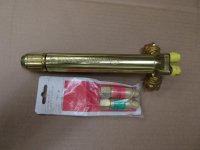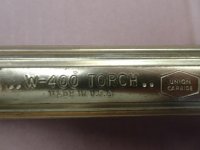Used oxyacetylene equipment is a grab-bag. I have had a Victor cutting and welding outfit for over 45 years. I went heavy at the start, getting new two-stage regulators since I knew I'd be doing heavy cutting and using large rosebuds (heating tips). I did get a used Victor cutting attachment, mixing handle, welding tips and rosebud. I invested in new hose. I've used that outfit for over 45 years with no complaints.
The problem with a lot of used regulators is the people who used them. Sounds silly, I know. When I was a kid, the oldtimers who taught me used to be fanatical that when I was done using an oxyacetylene outfit or anything with similar regulators, I was to back off the thumbscrews to relax the springs and diaphragms. After that, I was taught to bleed down the hoses and then shut the valves on the torch. Many people simply leave the regulators adjusted as they are and when they turn on the valves on the cylinders of compressed gasses, the regulators are slugged with that surge of pressure. The other problem is over time the springs and diaphragms, if left with some load on them, will "take a set", and the regulator will not hold pressure accurately or have a possible "leak by" from a cracked diaphragm.
You can tell a lot just looking at oxyacetylene outfits. On construction sites and heavy fabrication shops where the people do not own the equipment are often in a hurry, the equipment takes a real beating. I've been on jobs where I've seen men in the trades use the back of the cutting torch as a hammer to knock out a burned slug of metal when burning holes in plate or pipe. Hoses get brittle with age, as do O rings used to seal the torch components. Regulators are often thrown haphazardly into gang boxes or boxes on welding trucks. In short, if an outfit looks beat up on the outside, the inside works of it are probably not much better.
As for choices of oxyacetylene outfits, my advice is to stick to a known manufacturer so parts and service are available. The top of the heap here in the USA used to be Smith's. Smith's made a fine line of oxyacetylene equipment. Smith;s used to use knurled gland nuts on their torches and cutting attachments so that people did not over-tighten the connections between torch tips and torches or cutting attachments. SMith's never disappointed me, but they were pricier and less common back when I was getting a cutting outfit of my own. We had Victor outfits on the powerplant jobsites and they held up well. The local welding supply carried Victor, so that is what I went with.
Nowadays, there are a lot of knockoffs of Victor equipment. Even Victor themselves have some of their torches and regulators made or assembled in Mexico if I am not mistaken. As I said, I have no complaints and only good things to say about my own Victor oxyacetylene outfit. I also got an ancient Victor J-27 "aircraft torch"- a kind of semi-miniature torch- from a dentist who did bridgework and similar. It is a dandy little torch for fine work and I run it off the same regulators and tanks as the regular full sized outfit.
Smiths used to be an independent manufacturer of torches, but I think like so many other firms, they were absorbed by one of the conglomerates. As Bill notes, they always made what I considered the best torches and regulators. If I came by used Smith's equipment, I would grab it if it did not look beat up. As I said, on jobsites, I've seen men do things to torches that made me cringe. Probably the worst and most suicidal thing I ever saw was on a powerplant jobsite. The millwrights in a shed without benefit of compressed air, were running die grinders off the oxygen bottle on their cutting outfit. If you look on the faces of the gauges on the regulators it will always say: "Use no Oil". There is a reason for that, and oxygen will accelerate combustion and can produce an explosive result.
As if that was not bad enough, on that same jobsite, I was out in the laydown area looking for materials for a job. At the edge of the laydown area, the Operating Engineers had an equipment repair shop in a temporary building. One of their "mechanics" was attempting to unclog a fuel filter for a John Deere piece of equipment. The filter was a molded plastic box type, with two "O" rings to seal it against the ports on the side of the engine. This "mechanic" had a lit cigarette hanging out of his face and had shoved the tip of a cutting torch into one of the ports on the filter body and was back blowing the filter. To help dissolve whatever crud had clogged the filter, the mechanic had a pail of gasoline that he'd evidently immersed the filter in before attempting to back blow it with the torch. The smell or raw gasoline was in the air, and this nut with his cigarette was blasting oxygen into that fuel filter. I was about 23 at the time and given to being cocky and taking chances, but this guy was like a textbook or safety film of everything a person should not do. I hollered at him, and he grinned and hollered back, telling me he did this sort of thing "all the time" and telling me not to worry. I RAN a good piece from that nut. The sad part was no one in supervision paid any attention to this sort of thing. Meanwhile, the jobsite had safety meetings, safety posters all over the place, books of safety rules we had to read and sign... and this sort of thing went on with people using oxygen in ways that should have blown them off the map. I suppose there may be some truth to the saying that God watches over fools and little boys...
Look over a used oxyacetylene outfit carefully. If it has carbon black around the joints on the torch, chances are things are not sealing as they should and some acetylene leakage is happening. Possibly fixable with new O rings, possibly a distorted or dinged seating surface. If it looks like the head of the cutting torch was used as a hammer, or the tubes between the mixing barrel and the cutting head are pinched together and bent, stay away.
Check the gauges on the regulators and be sure the pointers sit right at zero, and the gauge housings are solidly mounted and nothing sounds loose or rattly in the gauges. If you see pipe wrench marks or vise-grip marks on the fittings and parts, it's a sign someone who did not understand how these sorts of things go together and seal was at work, applying what I call "Gorilla Torque". Light torque to make up the joints on this sort of equipment is all that is needed. Either ground seats, coned seat, or O rings make the seals on most of it. If it looks like some drunken plumber's helper put the pipe wrenches to the torches or regulators, do not pursue buying them.
That's my 2 cents on the matter.




 but mostly they are pretty tough. and it was still fixable. the biggest thing is make sure your local welding shop has tips in stock or your going to always have to have extras on site. I have a selection of tips in the shop to cut up to 4"
but mostly they are pretty tough. and it was still fixable. the biggest thing is make sure your local welding shop has tips in stock or your going to always have to have extras on site. I have a selection of tips in the shop to cut up to 4"